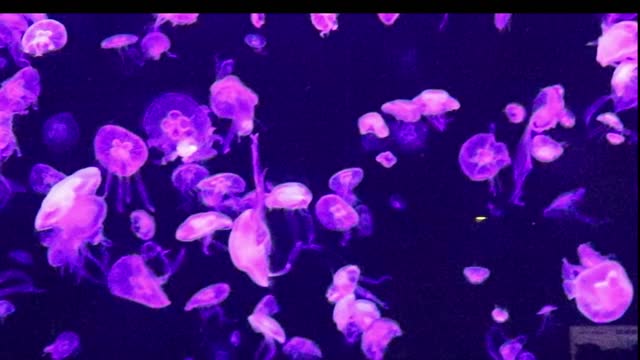Premium Only Content

Jelly fish overpowered by coloured lights!
1. Some jellyfish can glow in the dark
Many jellyfish have bioluminescent organs which emit blue or green light.
The light emission is typically activated by touch, which serves to startle predators. This light may also help jellyfish in a number of other ways, like attracting prey or warning other organisms that a particular area is occupied.
2. Jellyfish are the oldest multi-organ animal
Jellyfish have roamed the seas for at least 600 million years! Yes, before dinosaurs or bony fish, before creepy crawlies or trees, before flowers or ferns or fungi – there were jellyfish.
Jellyfish have survived five mass extinctions, including the Great Dying (or the Permian-Triassic extinction event) which wiped out up to 70% of life on Earth.
3. Jellyfish don’t have brains
Not only that, they also have no blood, no bones, and no heart. However, they do have an elementary nervous system with receptors that detect light, vibrations, and chemicals in the water. These abilities, along with the sense of gravity, allow jellyfish to orient and navigate in the water.
4. Jellyfish are found all over the world
Jellyfish are found in every ocean in every corner of the planet, from the coldest freezing waters of the Arctic oceans, to the warm, temperate waters of the tropical oceans.
They exist in different water conditions; at different depths from the ocean floor to the surface. They’re even found in some freshwater lakes and ponds!
5. Some jellyfish are immortal
Ever dreamed about being immortal? The good news is that you can be immortal. The bad news is that you have to become a floating blob of jelly to do so.
That’s right, there’s a death-defying species of jelly conveniently called the immortal jellyfish (or Turritopsis dohrnii) found in the Mediterranean Sea and in the waters of Japan that’s biologically immortal.
6. Not all jellyfish have tentacles
What are jellyfish known for? Some may say their trailing tentacles, but actually not all jellyfish species have tentacles. The Deepstaria, for example, is a genus of jellyfish known for their thin, sheet-like bodies and their lack of tentacles.
7. There’s a giant jellyfish called the hair jelly
The lion’s mane jellyfish (Cyanea capillata) – also known as the giant jellyfish or the hair jelly – is the largest known species of jellyfish.
The largest recorded specimen was found washed up on the shore of Massachusetts Bay in 1870. It had a bell with a diameter of 7 feet 6 inches and tentacles 121.4 feet long – longer than a blue whale and is considered one of the longest known animals in the world.
8. 150 million people are stung by jellyfish each year
That means that in the few minutes or so it’s taken you to read this far, more than 1,000 people have been stung by jellies.
9. Jellyfish stings can be deadly
The Australian box jellyfish (Chironex fleckeri) is considered the most venomous marine animal on earth. Its sting can cause paralysis, cardiac arrest, and death within a few minutes – barely enough time for a victim to swim to shore!
10. Jellyfish have many predators
Despite their venomous defenses, jellyfish are not without predators. Tunas, sharks, swordfish, sea turtles, and even some species salmon are jellyfish’s natural enemies that are known to prey upon jellies.
*All the information is obtained by open source, neither do I guarantee the authenticity nor do I claim ownership of the same
-
 3:44:06
3:44:06
Rising Rhino
12 hours ago $11.89 earnedWashington Commanders Vs Philadelphia Eagles: NFL NFC Championship LIVE Watch Party
56.3K4 -
 13:00
13:00
Exploring With Nug
6 hours ago $1.11 earnedHe Went To Get A Haircut And Vanished WIthout a Trace!
44.1K2 -
 18:53
18:53
DeVory Darkins
1 day ago $8.09 earnedTrump JUST ENDED Mayor Karen Bass During HEATED Meeting
85.5K213 -
 21:06
21:06
Russell Brand
10 hours agoIT'S COMING
142K478 -
 21:26
21:26
Stephen Gardner
1 day ago🔥What JUST leaked out of Congress must be STOPPED NOW!
132K282 -
 53:25
53:25
tether
11 days agoStability and Freedom in Chaos: The Story of Tether USD₮ | Tether Documentary (USDT)
144K5 -
 56:44
56:44
VSiNLive
2 days agoFollow the Money with Mitch Moss & Pauly Howard | Hour 1
80.9K2 -
 36:50
36:50
Anthony Pompliano
2 days ago $16.44 earnedInvestors Are ALL-IN On Bitcoin
73.5K20 -
 32:19
32:19
SB Mowing
9 days agoA Backyard She’s NEVER Seen – Now Safe for the Kids to Play!
67.6K29 -
![[Day 26] CS Blast bounty baby](https://1a-1791.com/video/fwe2/8a/s8/1/Z/H/j/_/ZHj_w.0kob-small-Day-26-CS-Blast-bounty-baby.jpg) 2:09:11
2:09:11
ggezlol_tv
14 hours ago[Day 26] CS Blast bounty baby
98.9K3